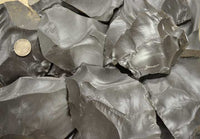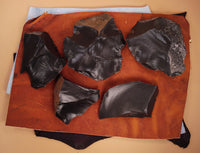Dacite Spalls 3-6 inch (per lb)
Considerably less glass-like than Obsidian, these medium to large Dacite spalls are an all around great volcanic flintknapping stone. Sold by the pound (1-2 pieces per lb).
Dacite is a highly knappable volcanic stone similar to Obsidian in many ways but considerably more textured and less glass-like. Knappability falls midway between cherts like Novaculite and Obsidian volcanic glass.
Our cleaned and graded Dacite spalls range in size from 3-6 inch pieces. This size is good for large and medium points and blades. Ordering 1 pound of this material will not ensure that you will get a single 6 inch spall. Most often a one pound order will contain two pieces of stone in the approx 4 inch range. To make certain you receive the full range of sizes of this material you will need to order multiple pounds or purchase a flat rate box of material.
WARNING: Dacite flakes can be sharper than razor blades! Exercise extreme caution!
We strive to provide the cleanest, blemish free knapping material within our means. On some spalls however, blemishes do get past us because not all defects are evident at first or even second inspection. In efforts to avoid defects as much as possible, we perform a few thinning blows to ensure that you do not pay for large amounts of waste, over thick spalls, or fragile/thin sizes that will shatter with the first strike.
Large knapping material requires large billets. Attempting to knap large stone with too small of a billet will damage the billet and not produce sizable thinning flakes early on in the process as needed. If you are graduating to this size material from one of our kits, we recommend adding a large copper percussion billet to your order. If you are unsure about what you need, please visit our Flintknapping Buyer's Guide, or feel free to contact us and we will be glad to help.
General Information on Dacite
Dacite is an igneous, volcanic rock. The word dacite comes from Dacia, a province of the Roman Empire which lay between the Danube River and Carpathian Mountains (now modern Romania) where the rock was first described.
Dacite usually forms as an intrusive rock such as a dike or sill. Examples of this type of dacite outcrop are found in northwestern Montana and northeastern Bulgaria. Nevertheless, because of the moderate silica content, dacitic magma is quite viscous and therefore prone to explosive eruption. A notorious example of this is Mount St. Helens in which dacite domes formed from previous eruptions.
Dacitic magma is formed by the subduction of young oceanic crust under a thick felsic continental plate. Oceanic crust is hydrothermally altered causing addition of quartz and sodium. As the young, hot oceanic plate is subducted under continental crust, the subducted slab partially melts and interacts with the upper mantle through convection and dehydration reactions. Once at the cold surface, the sodium rich magma crystallizes plagioclase, quartz and hornblende. Accessory elements like pyroxenes provide insight to the history of the magma.
The formation of dacite provides a great deal of information about the connection between oceanic crust and continental crust. It provides a model for the generation of felsic, buoyant, perennial rock from a mafic, dense, short-lived one.








